2008 INFINITI QX56 lock
[x] Cancel search: lockPage 3071 of 4083
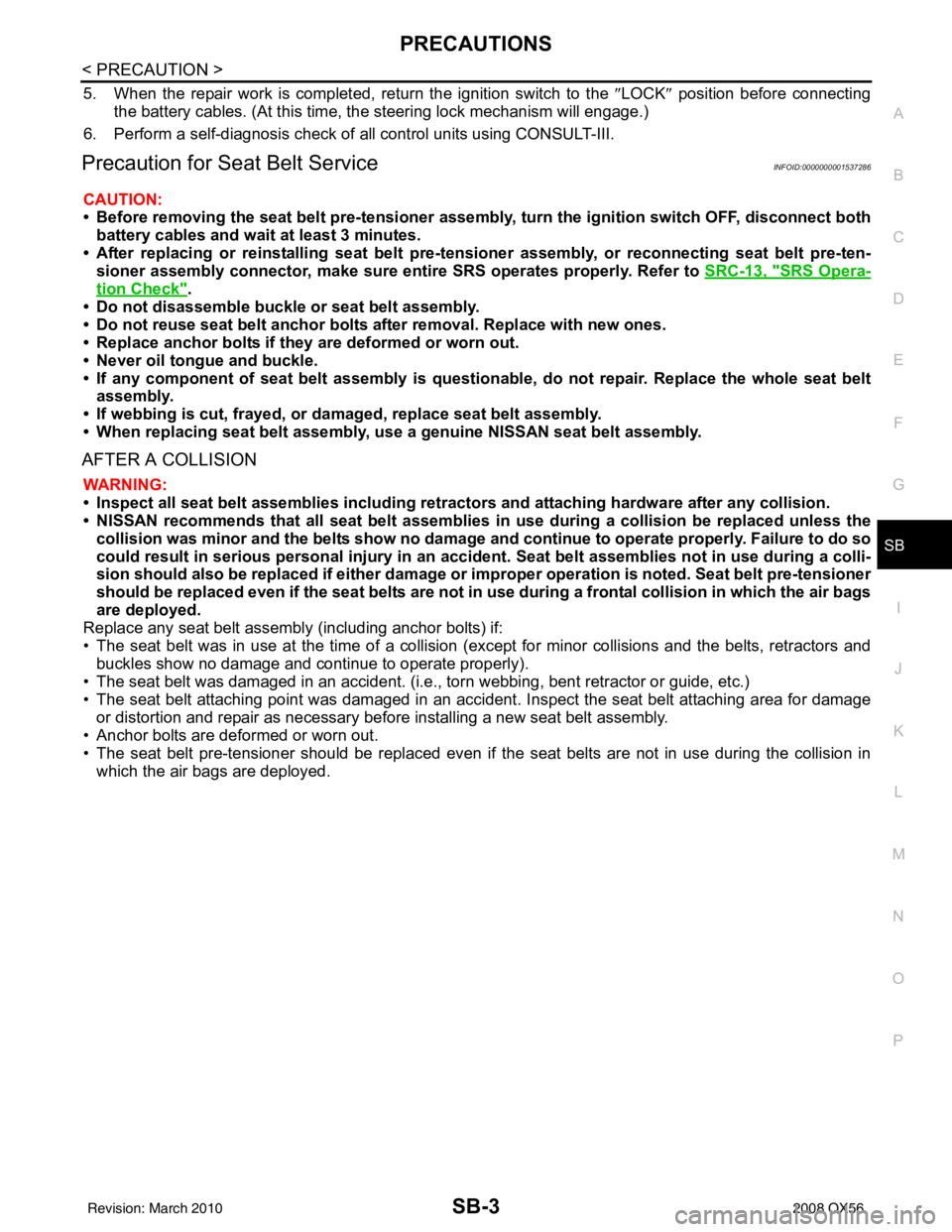
PRECAUTIONSSB-3
< PRECAUTION >
C
DE
F
G
I
J
K L
M A
B
SB
N
O P
5. When the repair work is completed, return the ignition switch to the ″LOCK ″ position before connecting
the battery cables. (At this time, the steering lock mechanism will engage.)
6. Perform a self-diagnosis check of al l control units using CONSULT-III.
Precaution for Seat Belt ServiceINFOID:0000000001537286
CAUTION:
• Before removing the seat belt pre-tensioner assembly, turn the ignition switch OFF, disconnect both
battery cables and wait at least 3 minutes.
• After replacing or reinstalling seat belt pre-tensioner assembly, or reconnecting seat belt pre-ten- sioner assembly connector, make sure entire SRS operates properly. Refer to SRC-13, "
SRS Opera-
tion Check".
• Do not disassemble buckle or seat belt assembly.
• Do not reuse seat belt anchor bolts after removal. Replace with new ones.
• Replace anchor bolts if th ey are deformed or worn out.
• Never oil tongue and buckle.
• If any component of seat belt assembly is questio nable, do not repair. Replace the whole seat belt
assembly.
• If webbing is cut, frayed, or damaged, replace seat belt assembly.
• When replacing seat belt assembly, u se a genuine NISSAN seat belt assembly.
AFTER A COLLISION
WARNING:
• Inspect all seat belt assemblies including retractors and attaching hardware after any collision.
• NISSAN recommends that all seat belt assemblies in use during a collision be replaced unless the
collision was minor and the belts show no damage and continue to operate properly. Failure to do so
could result in serious personal injury in an acci dent. Seat belt assemblies not in use during a colli-
sion should also be replaced if either damage or im proper operation is noted. Seat belt pre-tensioner
should be replaced even if the seat belts are not in use during a frontal collision in which the air bags
are deployed.
Replace any seat belt assembly (including anchor bolts) if:
• The seat belt was in use at the time of a collision (except for minor collisions and the belts, retractors and
buckles show no damage and continue to operate properly).
• The seat belt was damaged in an accident. (i.e., torn webbing, bent retractor or guide, etc.)
• The seat belt attaching point was damaged in an accident. Inspect the seat belt attaching area for damage or distortion and repair as necessary before installing a new seat belt assembly.
• Anchor bolts are deformed or worn out.
• The seat belt pre-tensioner should be replaced even if t he seat belts are not in use during the collision in
which the air bags are deployed.
Revision: March 2010 2008 QX56
Page 3073 of 4083
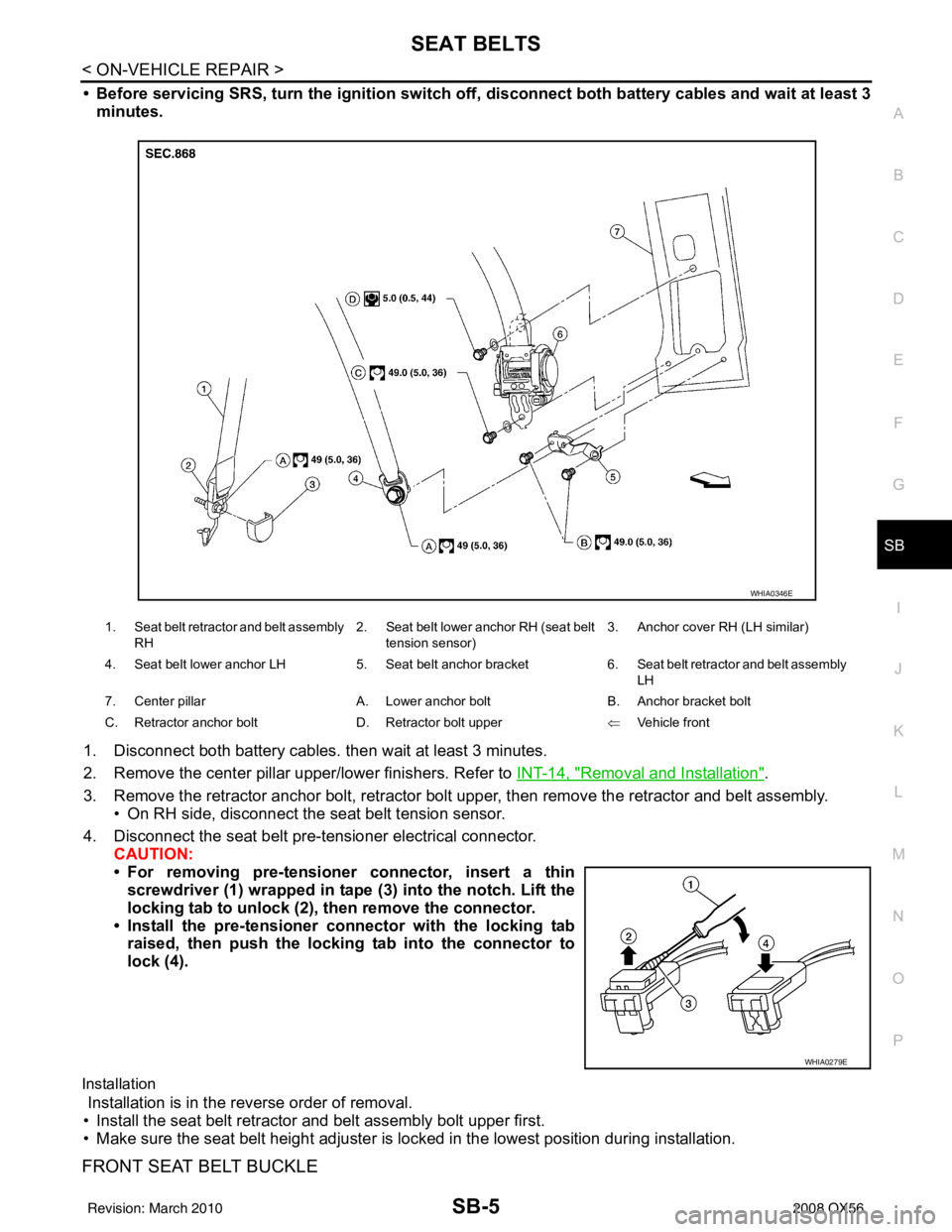
SEAT BELTSSB-5
< ON-VEHICLE REPAIR >
C
DE
F
G
I
J
K L
M A
B
SB
N
O P
• Before servicing SRS, turn the igni tion switch off, disconnect both battery cables and wait at least 3
minutes.
1. Disconnect both battery cables. then wait at least 3 minutes.
2. Remove the center pillar upper/lower finishers. Refer to INT-14, "
Removal and Installation".
3. Remove the retractor anchor bolt, retractor bolt upper, then remove the retractor and belt assembly. • On RH side, disconnect the seat belt tension sensor.
4. Disconnect the seat belt pre-tensioner electrical connector. CAUTION:
• For removing pre-tensioner connector, insert a thinscrewdriver (1) wrapped in tape (3) into the notch. Lift the
locking tab to unlock (2), then remove the connector.
• Install the pre-tensioner co nnector with the locking tab
raised, then push the locking tab into the connector to
lock (4).
Installation
Installation is in the reverse order of removal.
• Install the seat belt retractor and belt assembly bolt upper first.
• Make sure the seat belt height adjuster is lo cked in the lowest position during installation.
FRONT SEAT BELT BUCKLE
1. Seat belt retractor and belt assembly
RH 2. Seat belt lower anchor RH (seat belt
tension sensor) 3. Anchor cover RH (LH similar)
4. Seat belt lower anchor LH 5. Seat belt anchor bracket6. Seat belt retractor and belt assembly
LH
7. Center pillar A. Lower anchor boltB. Anchor bracket bolt
C. Retractor anchor bolt D. Retractor bolt upper ⇐Vehicle front
WHIA0346E
WHIA0279E
Revision: March 2010 2008 QX56
Page 3074 of 4083
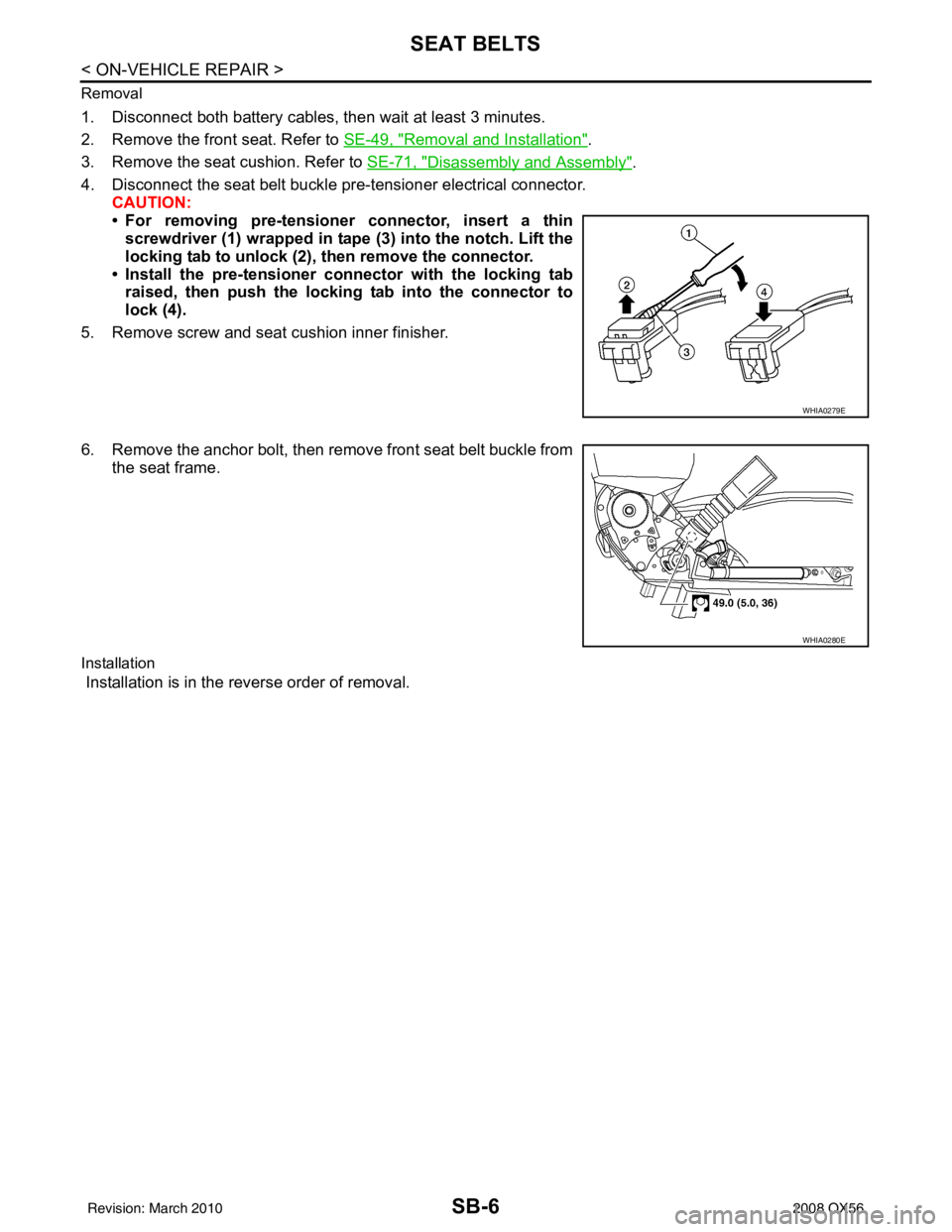
SB-6
< ON-VEHICLE REPAIR >
SEAT BELTS
Removal
1. Disconnect both battery cables, then wait at least 3 minutes.
2. Remove the front seat. Refer to SE-49, "
Removal and Installation".
3. Remove the seat cushion. Refer to SE-71, "
Disassembly and Assembly".
4. Disconnect the seat belt buckle pre-tensioner electrical connector. CAUTION:
• For removing pre-tensioner connector, insert a thinscrewdriver (1) wrapped in tape (3) into the notch. Lift the
locking tab to unlock (2), then remove the connector.
• Install the pre-tensioner connector with the locking tab raised, then push the locking tab into the connector to
lock (4).
5. Remove screw and seat cushion inner finisher.
6. Remove the anchor bolt, then remove front seat belt buckle from the seat frame.
Installation
Installation is in the reverse order of removal.
WHIA0279E
WHIA0280E
Revision: March 2010 2008 QX56
Page 3076 of 4083
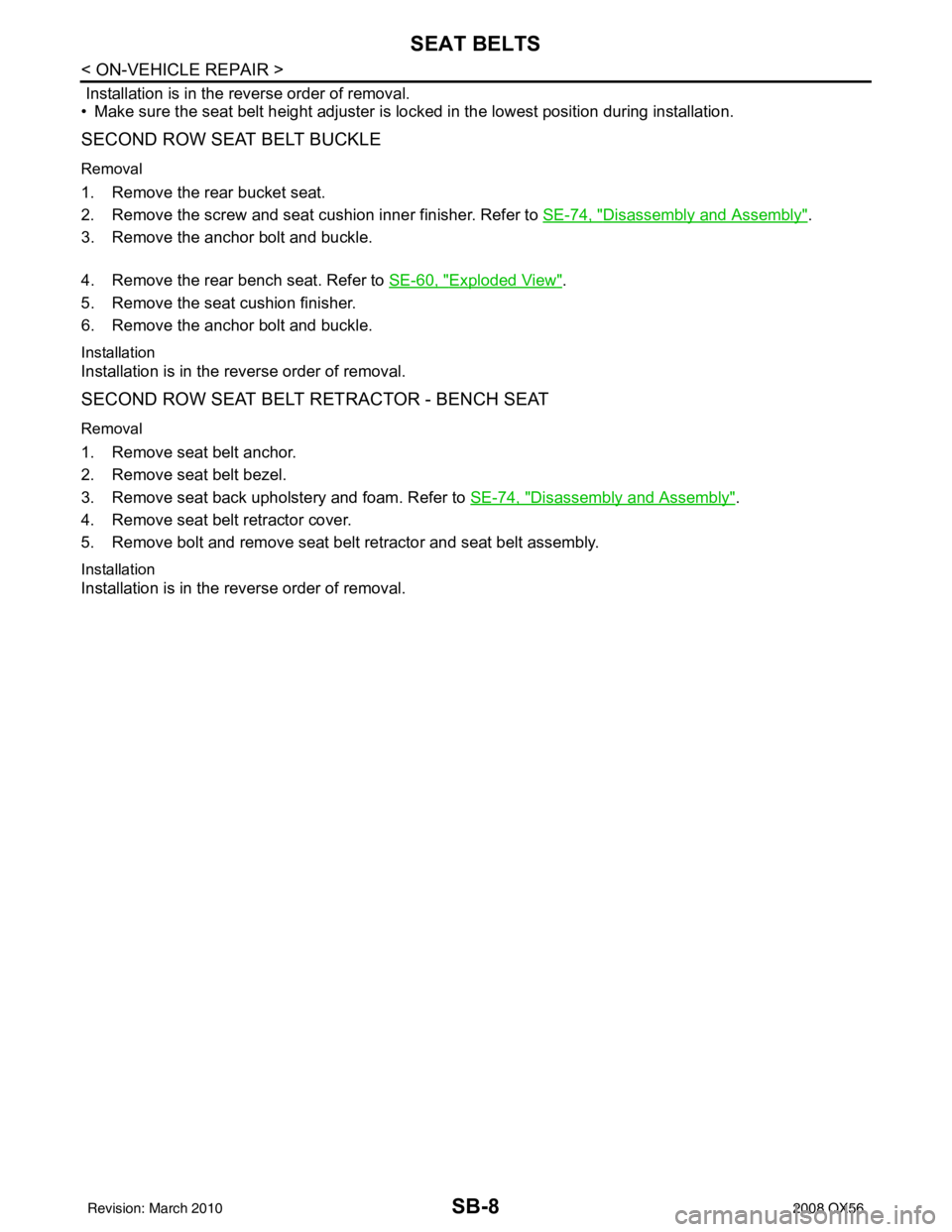
SB-8
< ON-VEHICLE REPAIR >
SEAT BELTS
Installation is in the reverse order of removal.
• Make sure the seat belt height adjuster is locked in the lowest position during installation.
SECOND ROW SEAT BELT BUCKLE
Removal
1. Remove the rear bucket seat.
2. Remove the screw and seat cushion inner finisher. Refer to SE-74, "
Disassembly and Assembly".
3. Remove the anchor bolt and buckle.
4. Remove the rear bench seat. Refer to SE-60, "
Exploded View".
5. Remove the seat cushion finisher.
6. Remove the anchor bolt and buckle.
Installation
Installation is in the reverse order of removal.
SECOND ROW SEAT BELT RETRACTOR - BENCH SEAT
Removal
1. Remove seat belt anchor.
2. Remove seat belt bezel.
3. Remove seat back upholstery and foam. Refer to SE-74, "
Disassembly and Assembly".
4. Remove seat belt retractor cover.
5. Remove bolt and remove seat belt retractor and seat belt assembly.
Installation
Installation is in the reverse order of removal.
Revision: March 2010 2008 QX56
Page 3079 of 4083
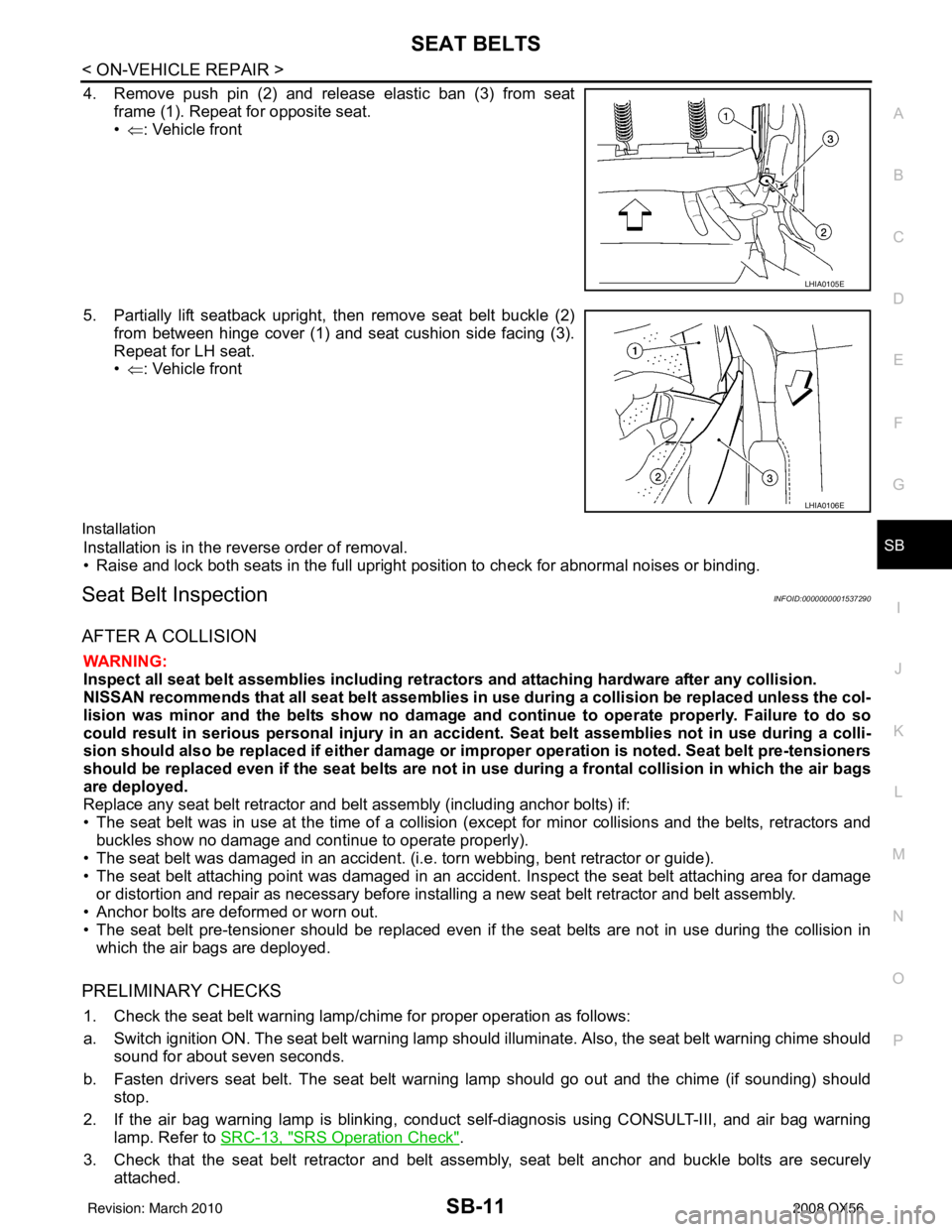
SEAT BELTSSB-11
< ON-VEHICLE REPAIR >
C
DE
F
G
I
J
K L
M A
B
SB
N
O P
4. Remove push pin (2) and release elastic ban (3) from seat frame (1). Repeat for opposite seat.
•⇐ : Vehicle front
5. Partially lift seatback upright, then remove seat belt buckle (2) from between hinge cover (1) and seat cushion side facing (3).
Repeat for LH seat.
•⇐ : Vehicle front
Installation
Installation is in the reverse order of removal.
• Raise and lock both seats in the full upright position to check for abnormal noises or binding.
Seat Belt InspectionINFOID:0000000001537290
AFTER A COLLISION
WARNING:
Inspect all seat belt assemblies including retractors and attaching hardware after any collision.
NISSAN recommends that all seat belt assemblies in u se during a collision be replaced unless the col-
lision was minor and the belts show no damage and continue to operate properly. Failure to do so
could result in serious personal injury in an accide nt. Seat belt assemblies not in use during a colli-
sion should also be replaced if either damage or im proper operation is noted. Seat belt pre-tensioners
should be replaced even if the seat belts are not in use during a frontal collision in which the air bags
are deployed.
Replace any seat belt retractor and belt assembly (including anchor bolts) if:
• The seat belt was in use at the time of a collision (except for minor collisions and the belts, retractors and buckles show no damage and continue to operate properly).
• The seat belt was damaged in an accident. (i.e. torn webbing, bent retractor or guide).
• The seat belt attaching point was damaged in an accident. Inspect the seat belt attaching area for damage
or distortion and repair as necessary before installing a new seat belt retractor and belt assembly.
• Anchor bolts are deformed or worn out.
• The seat belt pre-tensioner should be replaced even if t he seat belts are not in use during the collision in
which the air bags are deployed.
PRELIMINARY CHECKS
1. Check the seat belt warning lamp/chime for proper operation as follows:
a. Switch ignition ON. The seat belt warning lamp should illuminate. Also, the seat belt warning chime should sound for about seven seconds.
b. Fasten drivers seat belt. The seat belt warning lamp should go out and the chime (if sounding) should stop.
2. If the air bag warning lamp is blinking, conduct self-diagnosis using CONSULT-III, and air bag warning
lamp. Refer to SRC-13, "
SRS Operation Check".
3. Check that the seat belt retractor and belt asse mbly, seat belt anchor and buckle bolts are securely
attached.
LHIA0105E
LHIA0106E
Revision: March 2010 2008 QX56
Page 3080 of 4083

SB-12
< ON-VEHICLE REPAIR >
SEAT BELTS
4. Check the shoulder seat belt guide and shoulder belt height adjuster for\
front seats. Ensure guide swivelsfreely and that belt lays flat and does not bind in guide. Ensure height adjuster operates properly and
holds securely.
5. Check retractor operation:
a. Fully extend the seat belt webbing and check for twists, tears or other damage.
b. Allow the seat belt to retract. Ensure that belt retu rns smoothly and completely into the retractor. If the
seat belt does not return smoothly, wipe the inside of the loops with a clean paper cloth, because dirt built
up in the loops of the upper anchors can c ause the seat belts to retract slowly.
c. Fasten the seat belt. Check the seat belt returns smoothly and completely to the retractor. If the belt does not return smoothly, the cause may be an accumulati on of dust or dirt. Use the “SEAT BELT TAPE SET”
and perform the following steps.
Inspect the front seat belt through-anchor:1. Pull the seat belt out to a length of 500 mm (19.69 in) or more.
2. Use a clip or other device to hold the seat belt at the center pillar belt opening.
3. Pass a thin wire through the through-anchor belt opening. Hold both ends of the wire and pull taut while moving it up and down several times along the belt opening surface to remove dirt.
4. Any dirt that cannot be removed with the wir e can be removed by cleaning the opening with a clean
cloth.
5. Apply tape at the point where the belt contacts the through-anchor belt opening.
NOTE:
Apply the tape so that there is no looseness or wrinkling.
6. Remove the clip holding the seat belt and check that the belt returns smoothly.
7. Repeat steps above as necessary to check the other seat belts.
SEAT BELT RETRACTOR ON-VEHICLE CHECK
Emergency Locking Retractors (ELR) and Automatic Locking Retractors (ALR)
NOTE:
All seat belt retractors are of the Emergency Locking Retractors (ELR) type. In an emergency (sudden stop)
the retractor will lock and prevent the belt from ext ending any further. All 3-point type seat belt retractors
except the driver's seat belt also have an Automati c Locking Retractors (ALR) mode. The ALR mode (also
called child restraint mode) is used when installing child seats. The ALR mode is activated when the seat belt
is fully extended. When the belt is then retracted partiall y, the ALR mode automatically locks the seat belt in a
specific position so the belt cannot be extended any furt her. To cancel the ALR mode, allow the seat belt to
fully wind back into the retractor.
Check the seat belt retractors using the following test(s ) to determine if a seat belt retractor and belt assembly
is operating properly.
ELR Function Stationary Check
Grasp the shoulder belt and pull forward quickly. The re tractor should lock and prevent the belt from extending
further.
ALR Function Stationary Check
1. Pull out entire length of seat belt from retractor until a click is heard.
2. Retract the belt partially. A clicking noise should be hear d as the belt retracts indicating that the retractor is
in the Automatic Locking Retractor (ALR) mode.
3. Grasp the seat belt and try to pull out the retractor. The belt must lock and not extend any further. If neces-
sary replace the seat belt retractor and belt assembly.
4. Allow the entire length of the belt to re tract to cancel the automatic locking mode.
ELR Function Moving Check
WARNING:
Perform the following test in a safe, open area clear of other vehicles and obstructions (for example, a
large, empty parking lot). Road surface must be p aved and dry. DO NOT perform the following test on
wet or gravel roads or on public streets and highw ays. This could result in an accident and serious
personal injury. The driver and passenger must be prepared to brace themselves in the event the
retractor does not lock.
1. Fasten drivers seat belt. Buckle a passenger in to the seat for the belt that is to be tested.
Revision: March 2010 2008 QX56
Page 3081 of 4083

SEAT BELTSSB-13
< ON-VEHICLE REPAIR >
C
DE
F
G
I
J
K L
M A
B
SB
N
O P
2. Proceed to the designated safe area.
3. Drive the vehicle at approximately 16 km/h (10 MPH). Notify any passengers of a pending sudden stop. The driver and passenger must be prepared to brace t hemselves in the event the retractor does not lock.
Apply brakes firmly and make a very hard stop.
During stop, seat belts should lock and not be extended. If the seat belt retractor and belt assembly does not
lock, perform the retractor off-vehicle check.
SEAT BELT RETRACTOR OFF-VEHICLE CHECK
1. Remove the seat belt retractor and belt assembly.
2. Slowly pull out belt while tilting the retractor assembly forward from the mounted position without twisting
the retractor assembly as shown in the illustration.
If retractor does not operate within specif ications, replace the retractor assembly.
15 degrees or less tilt : Belt can be pulled out.
35 degrees or more tilt : Belt locks and cannot be pulled out.
PHIA0257E
Revision: March 2010
2008 QX56
Page 3084 of 4083
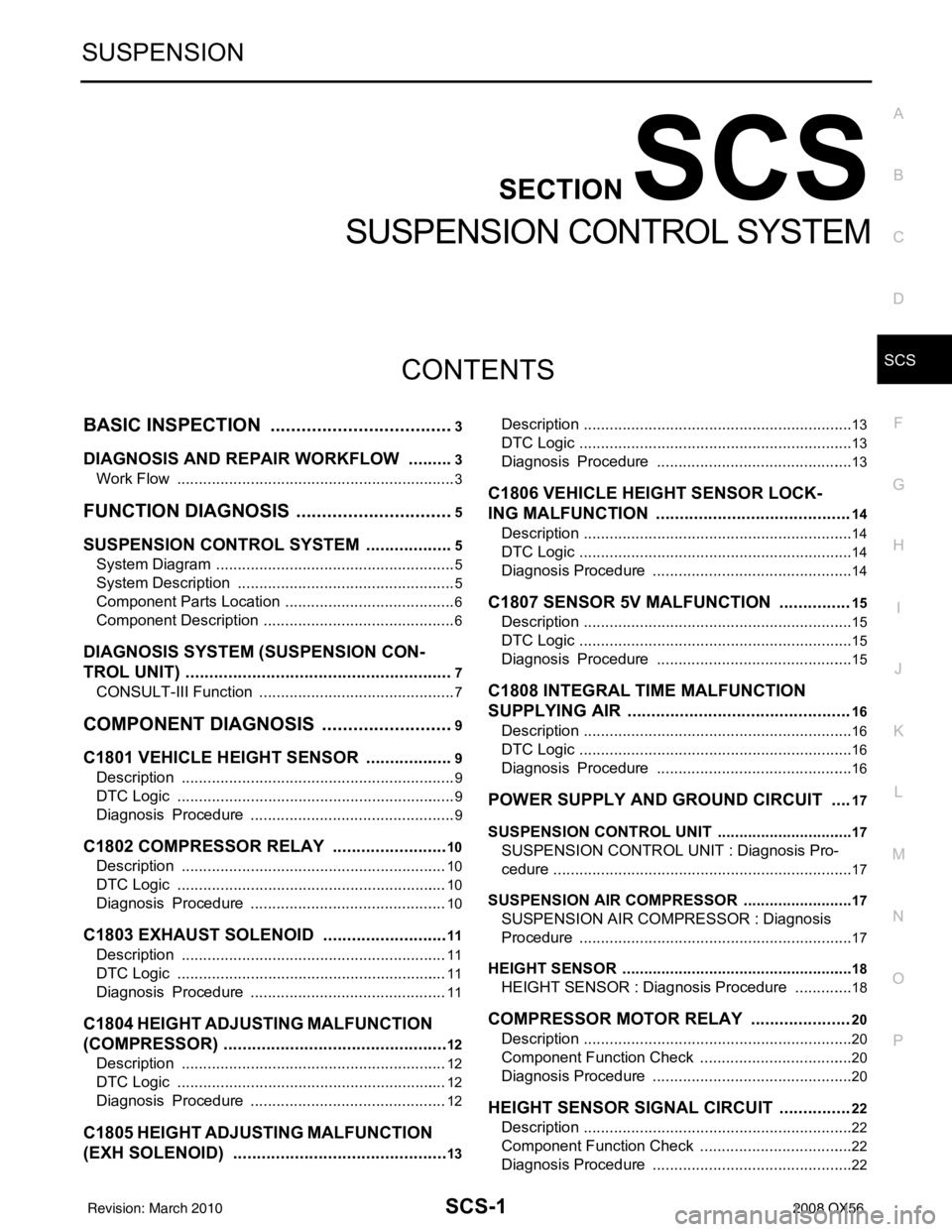
SCS-1
SUSPENSION
C
DF
G H
I
J
K L
M
SECTION SCS
A
B
SCS
N
O PCONTENTS
SUSPENSION CONTROL SYSTEM
BASIC INSPECTION ....... .............................3
DIAGNOSIS AND REPAIR WORKFLOW ..... .....3
Work Flow ........................................................... ......3
FUNCTION DIAGNOSIS ...............................5
SUSPENSION CONTROL SYSTEM .............. .....5
System Diagram .................................................. ......5
System Description ...................................................5
Component Parts Location ........................................6
Component Description .............................................6
DIAGNOSIS SYSTEM (SUSPENSION CON-
TROL UNIT) .........................................................
7
CONSULT-III Function ..............................................7
COMPONENT DIAGNOSIS ..........................9
C1801 VEHICLE HEIGHT SENSOR .............. .....9
Description .......................................................... ......9
DTC Logic .................................................................9
Diagnosis Procedure ................................................9
C1802 COMPRESSOR RELAY .........................10
Description ..............................................................10
DTC Logic ...............................................................10
Diagnosis Procedure ..............................................10
C1803 EXHAUST SOLENOID ...........................11
Description ..............................................................11
DTC Logic ...............................................................11
Diagnosis Procedure ..............................................11
C1804 HEIGHT ADJUSTING MALFUNCTION
(COMPRESSOR) ............................................ ....
12
Description .......................................................... ....12
DTC Logic ...............................................................12
Diagnosis Procedure ..............................................12
C1805 HEIGHT ADJUSTING MALFUNCTION
(EXH SOLENOID) ..............................................
13
Description ........................................................... ....13
DTC Logic ................................................................13
Diagnosis Procedure ..............................................13
C1806 VEHICLE HEIGHT SENSOR LOCK-
ING MALFUNCTION .........................................
14
Description ........................................................... ....14
DTC Logic ................................................................14
Diagnosis Procedure ...............................................14
C1807 SENSOR 5V MALFUNCTION ...............15
Description ...............................................................15
DTC Logic ................................................................15
Diagnosis Procedure ..............................................15
C1808 INTEGRAL TIME MALFUNCTION
SUPPLYING AIR ...............................................
16
Description ...............................................................16
DTC Logic ................................................................16
Diagnosis Procedure ..............................................16
POWER SUPPLY AND GROUND CIRCUIT ....17
SUSPENSION CONTROL UNIT ................................17
SUSPENSION CONTROL UNI T : Diagnosis Pro-
cedure .................................................................. ....
17
SUSPENSION AIR COMPRESSOR ..........................17
SUSPENSION AIR COMPRESSOR : Diagnosis
Procedure ............................................................ ....
17
HEIGHT SENSOR .................................................. ....18
HEIGHT SENSOR : Diagnosis Procedure ..............18
COMPRESSOR MOTOR RELAY .....................20
Description ...............................................................20
Component Function Check ....................................20
Diagnosis Procedure ...............................................20
HEIGHT SENSOR SIGNAL CIRCUIT ...............22
Description ...............................................................22
Component Function Check ....................................22
Diagnosis Procedure ...............................................22
Revision: March 2010 2008 QX56